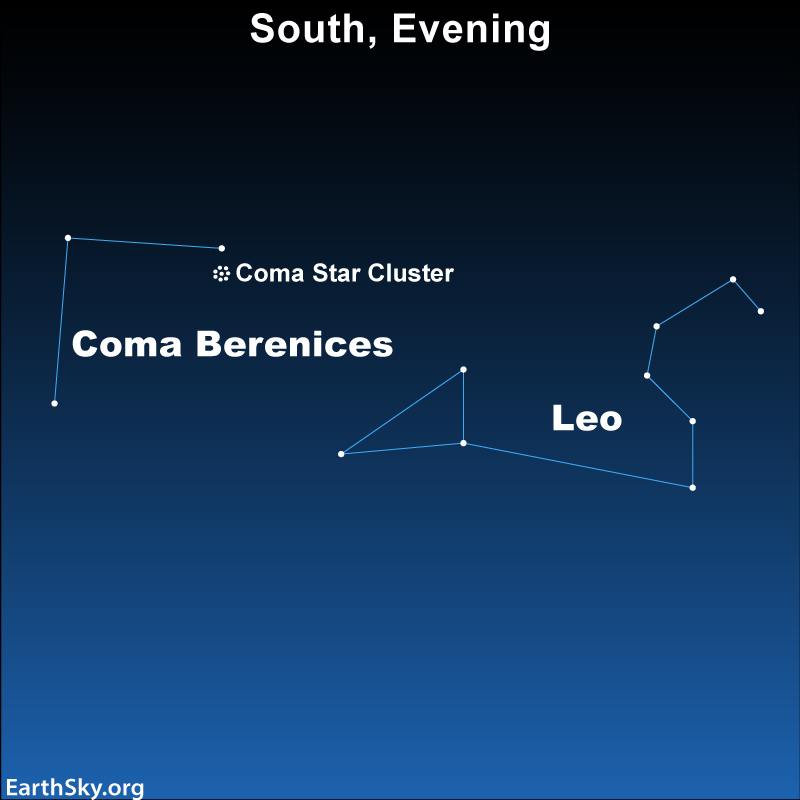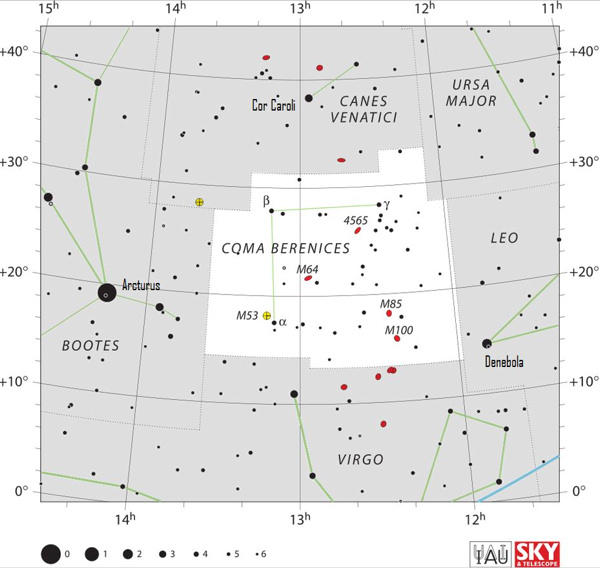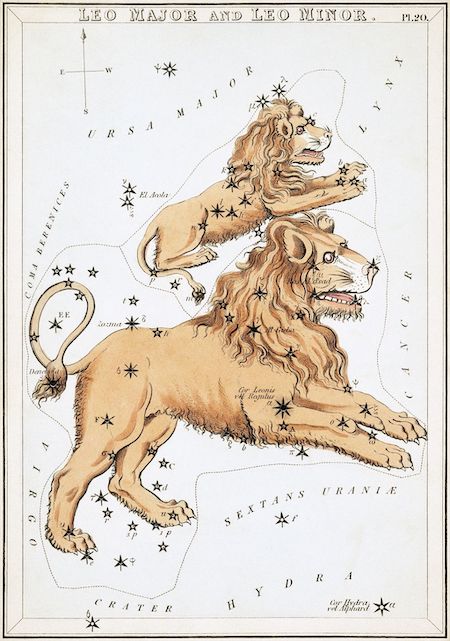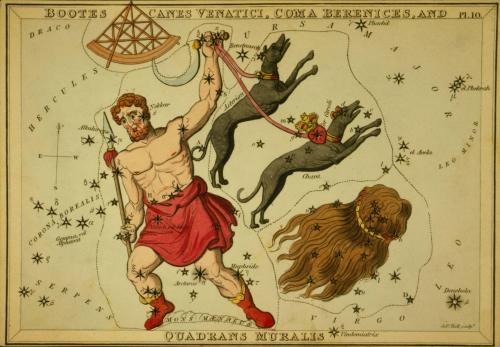
The constellation of Coma Berenices
Coma Berenices is a constellation readily visible in spring skies that represents the hair of Queen Berenice. The constellation itself may not be very bright – you’ll need a dark sky to see most of its stars – but its location is easy enough to find. It trails Leo the Lion, with the Big Dipper high above it and Virgo with bright Spica below.

Finding Coma Berenices
How can you find it? One way is to use the famous constellation Leo the Lion, shown on our chart at the top of this post. It’s now in the east each evening and Leo is relatively easy to see. The front part of the Lion looks like a backward question mark, and the back part is a little triangle, which includes the star Denebola, marked on the chart above. The word Deneb in a star name always means tail, and this star marks the tail of Leo.
Do you know how to use the pointer stars in the Big Dipper to locate Polaris, the North Star? Instead of going northward from the pointer stars to Polaris, go southward to find the constellation Leo.
Now imagine that Leo is holding its tail out. In the place where you might see a “puff” at the end of the Lion’s tail, you’ll notice a fuzzy patch not too far away from Denebola. This is the constellation Coma Berenices, or Berenice’s Hair. In fact, the constellation Coma Berenices was once part of the constellation Leo.
The stars of Berenice’s Hair
The three main stars in Coma Berenices are Alpha, Beta, and Gamma Comae Berenices. They form the upper left portion of a square. The brightest of these stars is Beta Comae Berenices, at magnitude 4.2. It lies at the corner of the partial square.
Near the star Gamma Comae Berenices, at the top of the half-box, is a famous star cluster. Under dark skies, you can find Melotte 111, although it is more familiarly known as the Coma star cluster.
A tangle of stars
To see Melotte 111, the Coma star cluster, you need a dark sky. It is an open star cluster, a loose collection of stars held together by gravity.
Under a dark sky, the Coma star cluster can look like a glint on the sky. If you can’t spot this wispy and glimmering group of stars with the unaided eye, try binoculars. The cluster is actually fairly large, covering 5 degrees of the sky.
See the chart below.

Viewing Tip: To enhance your view of the Coma star cluster, take a paper towel tube or roll up some dark paper into a tube and place it to your eye. The tube will shield your eye from the glare of any ground lights. Binoculars or opera glasses will also lead to a better viewing experience.
The Coma star cluster is estimated to be about 288 light-years away and has at least 37 known stars that are 400 million years old. It is the third-closest open cluster to our Earth and sun. Only the Ursa Major cluster (the bowl stars of the Big Dipper) and the Hyades cluster (the head of Taurus the Bull) are closer.
The Coma galaxy cluster
There is another Coma cluster in the constellation of Coma Berenices, but that one is a cluster of galaxies. The names of the two are easily confused.

Formerly part of Leo the Lion
On old star charts like the one below, the tail of the constellation Leo the Lion has a curve. There’s a star there, Beta Leonis or Denebola, whose name means tail. Yet – on the dome of the sky – the Lion’s Tail used to extend out straight behind Leo, and the constellation of the Lion encompassed a much-larger area of the sky. The Greek-Egyptian astronomer Ptolemy and others considered a modern-day constellation – which we call Coma Berenices – as the tuft at the end of Leo’s tail. It was only a few hundred years ago that Coma Berenices became a separate constellation.

Mythology of Coma Berenices
The official constellation is relatively new, but the lore behind the constellation is old. The story goes that an ancient Egyptian queen, Berenice, feared for her husband’s life as he went into battle. She prayed to Aphrodite, promising to cut off her long, luxurious curls if the king returned safely. He did, and Berenice kept her promise and cut off her hair, placing it as a sacrifice on Aphrodite’s altar.
But the next day the hair was gone!
The enraged king was angry that the temple priests had not protected the precious locks. A quick-thinking astronomer saved the day, or rather night, by pointing to the cascading stars at the end of Leo’s tail. He told the king that these were the queen’s tresses placed in the sky by Aphrodite for all to see.
This appeased the king and queen, and saved the priests from a beheading.
Thus, Leo lost his tail … and, ultimately, we gained a constellation.

Bottom line: Coma Berenices is the constellation of Queen Berenice’s Hair. It used to be the tail of Leo the Lion before it became its own constellation. It contains a large open star cluster easily viewed in binoculars.
Enjoying EarthSky so far? Sign up for our free daily newsletter today!
The post Coma Berenices: See how Leo the Lion lost his tail first appeared on EarthSky.
from EarthSky https://ift.tt/eJh97Fd

The constellation of Coma Berenices
Coma Berenices is a constellation readily visible in spring skies that represents the hair of Queen Berenice. The constellation itself may not be very bright – you’ll need a dark sky to see most of its stars – but its location is easy enough to find. It trails Leo the Lion, with the Big Dipper high above it and Virgo with bright Spica below.

Finding Coma Berenices
How can you find it? One way is to use the famous constellation Leo the Lion, shown on our chart at the top of this post. It’s now in the east each evening and Leo is relatively easy to see. The front part of the Lion looks like a backward question mark, and the back part is a little triangle, which includes the star Denebola, marked on the chart above. The word Deneb in a star name always means tail, and this star marks the tail of Leo.
Do you know how to use the pointer stars in the Big Dipper to locate Polaris, the North Star? Instead of going northward from the pointer stars to Polaris, go southward to find the constellation Leo.
Now imagine that Leo is holding its tail out. In the place where you might see a “puff” at the end of the Lion’s tail, you’ll notice a fuzzy patch not too far away from Denebola. This is the constellation Coma Berenices, or Berenice’s Hair. In fact, the constellation Coma Berenices was once part of the constellation Leo.
The stars of Berenice’s Hair
The three main stars in Coma Berenices are Alpha, Beta, and Gamma Comae Berenices. They form the upper left portion of a square. The brightest of these stars is Beta Comae Berenices, at magnitude 4.2. It lies at the corner of the partial square.
Near the star Gamma Comae Berenices, at the top of the half-box, is a famous star cluster. Under dark skies, you can find Melotte 111, although it is more familiarly known as the Coma star cluster.
A tangle of stars
To see Melotte 111, the Coma star cluster, you need a dark sky. It is an open star cluster, a loose collection of stars held together by gravity.
Under a dark sky, the Coma star cluster can look like a glint on the sky. If you can’t spot this wispy and glimmering group of stars with the unaided eye, try binoculars. The cluster is actually fairly large, covering 5 degrees of the sky.
See the chart below.

Viewing Tip: To enhance your view of the Coma star cluster, take a paper towel tube or roll up some dark paper into a tube and place it to your eye. The tube will shield your eye from the glare of any ground lights. Binoculars or opera glasses will also lead to a better viewing experience.
The Coma star cluster is estimated to be about 288 light-years away and has at least 37 known stars that are 400 million years old. It is the third-closest open cluster to our Earth and sun. Only the Ursa Major cluster (the bowl stars of the Big Dipper) and the Hyades cluster (the head of Taurus the Bull) are closer.
The Coma galaxy cluster
There is another Coma cluster in the constellation of Coma Berenices, but that one is a cluster of galaxies. The names of the two are easily confused.

Formerly part of Leo the Lion
On old star charts like the one below, the tail of the constellation Leo the Lion has a curve. There’s a star there, Beta Leonis or Denebola, whose name means tail. Yet – on the dome of the sky – the Lion’s Tail used to extend out straight behind Leo, and the constellation of the Lion encompassed a much-larger area of the sky. The Greek-Egyptian astronomer Ptolemy and others considered a modern-day constellation – which we call Coma Berenices – as the tuft at the end of Leo’s tail. It was only a few hundred years ago that Coma Berenices became a separate constellation.

Mythology of Coma Berenices
The official constellation is relatively new, but the lore behind the constellation is old. The story goes that an ancient Egyptian queen, Berenice, feared for her husband’s life as he went into battle. She prayed to Aphrodite, promising to cut off her long, luxurious curls if the king returned safely. He did, and Berenice kept her promise and cut off her hair, placing it as a sacrifice on Aphrodite’s altar.
But the next day the hair was gone!
The enraged king was angry that the temple priests had not protected the precious locks. A quick-thinking astronomer saved the day, or rather night, by pointing to the cascading stars at the end of Leo’s tail. He told the king that these were the queen’s tresses placed in the sky by Aphrodite for all to see.
This appeased the king and queen, and saved the priests from a beheading.
Thus, Leo lost his tail … and, ultimately, we gained a constellation.

Bottom line: Coma Berenices is the constellation of Queen Berenice’s Hair. It used to be the tail of Leo the Lion before it became its own constellation. It contains a large open star cluster easily viewed in binoculars.
Enjoying EarthSky so far? Sign up for our free daily newsletter today!
The post Coma Berenices: See how Leo the Lion lost his tail first appeared on EarthSky.
from EarthSky https://ift.tt/eJh97Fd

Aucun commentaire:
Enregistrer un commentaire